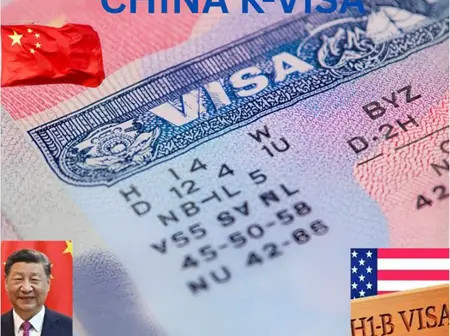Beijing, October 3, 2025 — China has launched a new “K-Visa” scheme aimed at attracting global STEM (Science, Technology, Engineering, and Mathematics) talent. Analysts are calling it a strategic response to recent changes in the United States’ H-1B visa program. With the K-Visa launch, China offers foreign professionals opportunities to live and work in the country for up to 180 days per year. This is over a five-year period, allowing for flexible work and academic collaboration across the country’s tech and research sectors.
The program is already making waves internationally and domestically. It gained particular traction after Indian media referred to it as “China’s H-1B”—a nod to the U.S. visa program for skilled workers. This was recently hit by a steep fee hike following an executive order from President Donald Trump. With Indian nationals constituting over 70% of H-1B holders, the new Chinese initiative has drawn keen interest from India’s tech community.
According to Dr. Fengming Lu, an expert in international labor mobility, the new K-Visa is “likely a direct response” to the U.S. move. “China is seizing the opportunity to present itself as an alternative hub for global talent, especially in AI, biotech, and advanced manufacturing,” he said. Clearly, the K-Visa launch in China signifies a calculated move in this global landscape.
Beijing’s strategic pivot underscores its broader ambitions to compete with the U.S. in technology and innovation. With Washington tightening access and increasing costs for foreign tech workers, China appears ready to position itself as a more accessible destination—at least on paper.
But not everyone in China is applauding the initiative. The announcement has ignited a wave of criticism on Chinese social media platforms. Many users voice concern that the new visa could further strain an already tight job market, particularly for young Chinese graduates.
The timing is sensitive. Youth unemployment in China remains stubbornly high, and public confidence in job prospects has been shaken by a sluggish post-COVID economic recovery. Critics argue that bringing in more foreign talent—particularly in tech, a sector seen as a career lifeline for many young Chinese—could lead to increased competition for already scarce opportunities.
“This is a slap in the face for local graduates,” one popular comment read on Weibo. “We’re struggling to find decent jobs, and now they want to bring in more competition?”
Adding to the controversy is the lack of transparency surrounding the program. It remains unclear whether the K-Visa will allow its holders to be formally employed by Chinese companies. Alternatively, it may simply grant them temporary access for collaboration and short-term projects. That ambiguity has only fueled public anxiety.
While the Chinese government has pitched the visa as a tool for fostering international academic and industrial cooperation, public opinion seems less convinced of its benefits for ordinary citizens. Some analysts believe the backlash highlights a broader discomfort within Chinese society toward large-scale immigration. This is an area where China has historically been relatively closed compared to other global powers.
Interest in the K-Visa has surged in India, where media coverage has been enthusiastic. They view it as a potential new gateway for skilled professionals displaced or disillusioned by U.S. immigration policy. However, experts warn that real uptake will depend on the fine print of the policy, China’s political climate, and ongoing geopolitical tensions between the two nations.
“Indian tech workers may see this as a theoretical alternative to the U.S., but many are wary of working in a country where language barriers, censorship, and diplomatic tensions could make life difficult,” noted one India-based immigration consultant. The cautious approach mirrors the mixed reactions since China introduced the K-Visa.
The K-Visa launch represents more than just a visa policy tweak—it’s a sign of how international talent mobility is becoming a new front in the geopolitical competition between the U.S. and China. While China attempts to lure skilled professionals with a more open-door approach, it must also manage growing domestic unease over the consequences.
Whether the K-Visa becomes a viable pathway for global tech workers—or merely a political signal—remains to be seen. But for now, it’s clear that the race for global talent is entering a new, more competitive phase. China launches the K-Visa amid this intensifying global race for innovation and talent.

Leave a Reply